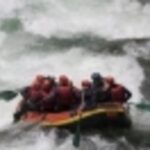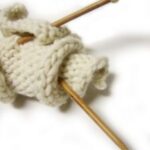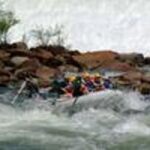Top 10 whitewater rafting safety tips for making your whitewater rafting trip even more fun and safe:
#1 Whitewater Rafting Safety Tip: Life Vest
Wear a life vest. It doesn’t matter how hot it gets outside or how uncomfortable you might feel in that vest. If you fall out, even in very slow water, and hit your head, that vest will save your life. Just don’t take it off at any time while you’re in the water.
#2 Whitewater Rafting Safety Tip: Water Shoes
You don’t need water shoes on a whitewater raft, and you can do fine without them. But at some point in time, you might need to step in the water, and if you’re wearing water shoes, you will be happier and safer. The water shoes will insulate your feet against the pointy parts of rocks and will make it easier for you on the slippery parts of rocks, too.
#3 Whitewater Rafting Safety Tip: Helmet
If you’re going on a class 1 or class 2 river, you don’t need a helmet. But if you’re headed to a class 3 or above, that helmet, like the life vest, can save your life. Sure, you hope you never have to use it, but when that wave hits you that you don’t see, you don’t get to control how and where you fall out of the boat. It doesn’t take much of a rock or a hit on the head to really hurt you. With a helmet, you might get hurt, but you won’t be killed.
#4 Whitewater Rafting Safety Tip: Paddles Down
When you’re rafting with others, keep your paddle down and near the water. When you get excited going through the rapids, this can be very difficult, but it will help everyone else in the boat. You won’t hit yourself with your own paddle, but you will easily hit someone else in the boat. If you keep the paddle down and outside the boat, you won’t hit anyone else, at least in your boat.
#5 Whitewater Rafting Safety Tip: The Buddy System
Don’t go out alone. You really shouldn’t even go out with just one raft. To be really safe, you need to have more than one person in more than one raft. If something happens to one person, there will be someone else there to either help or to go get help. If something happens to your raft, having a second person in a second raft will save you hours of walking for help as well.
#6 Whitewater Rafting Safety Tip: Plan & Notify Others
When you’re going out on a whitewater trip, make sure that you make a plan of where you will go and when you will be back. Then, be sure to tell someone else that’s not going where you will be and when you plan on returning. That way if something does happen to you while you’re on the trip, someone will know that you are missing and will know where to start looking for you. Without that, it may be Monday morning before someone knows you are missing and no one will know where to look for you.
#7 Whitewater Rafting Safety Tip: Check Your Equipment
Before you go, check out your raft, paddles, and any other equipment you’re taking on the trip. A few minutes of checking the air levels of the raft and the paddles for cracks can save you a lot of trouble and a lot of time once you’ve started down the river.
#8 Whitewater Rafting Safety Tip: Take Breaks
When you’re spending a number of hours going down a river, don’t forget to stop and take a break when you get tired. More difficult rapids take a large amount of concentration to make it through them and being tired will not help you. Just find a section of the river that’s not flowing so hard and paddle over and stop.
#9 Whitewater Rafting Safety Tip: Drink Water
One of the biggest dangers people face outdoors, away from civilization is dehydration. Even though you’re in a river, if you don’t drink enough water, dehydration can quickly sap your energy and make it even more difficult to make it out of the river. Don’t drink the river water, bring your own along for the trip, especially if you’re taking a trip of more than a few hours.
#10 Have Fun
If you’re not having fun, why did you even go on the trip? And if you’re not having fun, you will likely start doing things that are more dangerous than they need to be. So enjoy this great outdoor recreational activity and be safe so you can head out and do it again.




